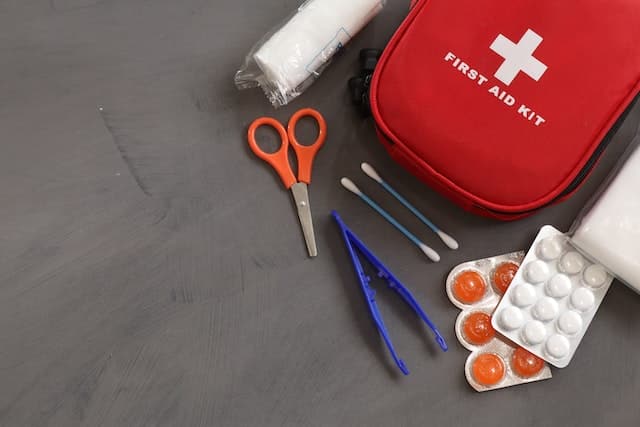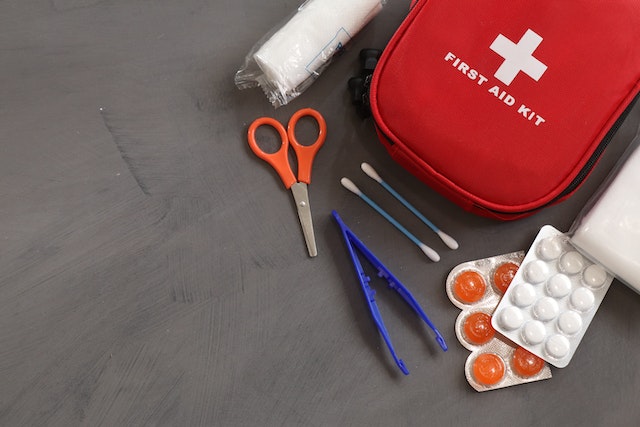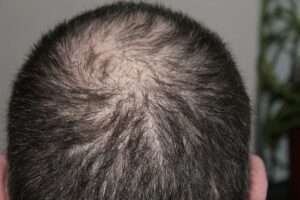1. Adhesive bandages (various sizes and fun designs): Adhesive bandages are essential in first aid for kids to cover and protect minor cuts, scrapes, or blisters.
Featuring kid-friendly designs, they help comfort and encourage children during treatment, promoting a positive healing experience.
2. Sterile gauze pads are essential in first aid for kids to dress and clean wounds.
They effectively absorb blood and exudates, creating a hygienic environment for healing. Properly applied, they help prevent infection and promote better recovery.
3. Adhesive tape is crucial in first aid for securing bandages and dressings, immobilizing injured areas, and supporting sprains or strains. It promotes wound healing and provides stability during recovery.
4. Antiseptic wipes or solution: Antiseptic wipes or solutions are essential in first aid to clean and disinfect wounds, cuts, and scrapes, reducing the risk of infection and promoting proper healing for better recovery.
4. Tweezers are used in first aid to safely remove splinters, debris, or small foreign objects from wounds.
They help prevent infection and promote proper wound care.
5. Scissors are used in first aid to cut bandages, clothing, or medical tape for wound dressing and to access injured areas safely. They aid in providing necessary medical care during emergencies.
5. Disposable gloves are crucial in first aid to maintain a hygienic environment and protect both the first aider and the patient from potential infections or contamination during wound care and medical procedures.
6. Instant cold pack: Useful for reducing swelling or relieving pain caused by minor injuries. An instant cold pack is used in first aid to provide immediate relief for minor injuries such as sprains, strains, and bruises.
By applying cold therapy, it helps reduce swelling, numb pain, and promote healing.
7. Saline solution is used in first aid to clean and irrigate wounds, flush out debris, and gently remove dirt or foreign particles.
It is a gentle, sterile solution that helps prevent infection and aids in wound healing.
8. Antibiotic ointment is used in first aid to apply on minor cuts, scrapes, and burns. It helps prevent infection by killing or inhibiting bacteria, promoting a sterile environment, and supporting the natural healing process for faster recovery.
9. Calamine lotion is used in first aid to relieve itching, irritation, and discomfort caused by minor skin conditions like rashes, insect bites, and poison ivy.
It soothes the skin and reduces inflammation for better healing.
Pain relievers such as acetaminophen or ibuprofen, can be used in first aid for kids to alleviate mild pain or fever due to injuries or illnesses.
However, it’s essential to follow proper dosing guidelines and consult a healthcare professional if needed.
Thermometer: A thermometer is used in first aid for kids to measure body temperature accurately.
It helps identify fever or potential health concerns, enabling parents or caregivers to take appropriate actions or seek medical advice promptly.
A small notepad and pen are handy in first aid for kids to record important information, such as the child’s symptoms, medication doses, and any relevant details for communication with healthcare professionals during emergencies or doctor visits.
Emergency contact information: Having emergency contact information readily available in first aid for kids is crucial.
This includes parents’ or guardians’ phone numbers, local emergency services, pediatrician’s contact, and any relevant medical details, ensuring quick communication and proper assistance during emergencies.
Conclusion
It’s essential to store the first aid kit in a cool, dry place out of the reach of children, but easily accessible in case of emergencies.
Additionally, make sure to regularly check and replenish supplies as needed. Remember that first aid kits are not a substitute for medical attention, so consult a healthcare professional for any serious injuries or concerns regarding your child’s health.







